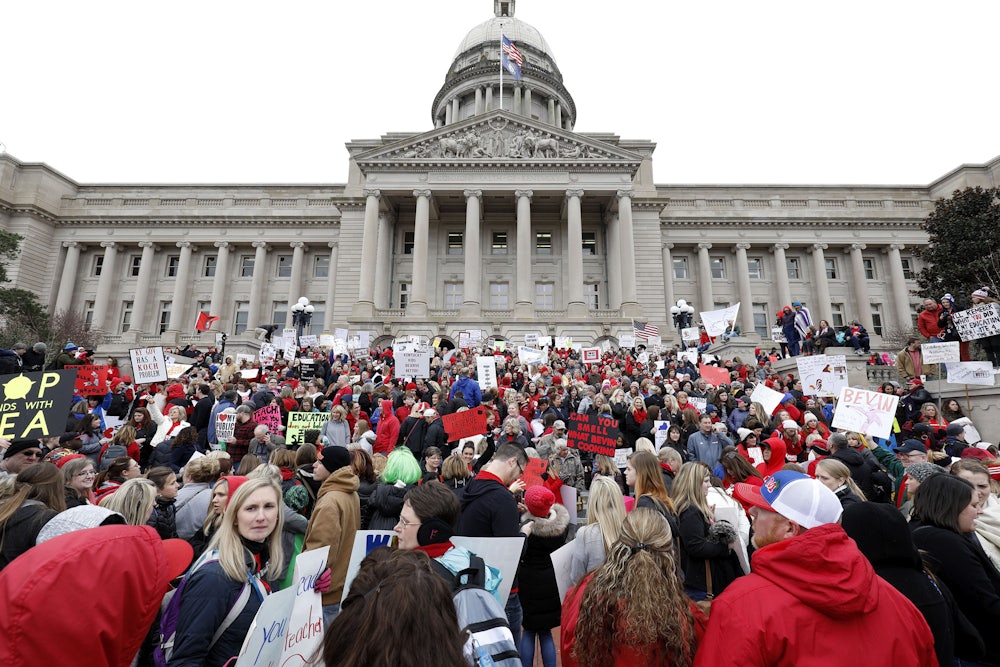Why Textbooks Are a Symbol of Teacher Frustration
One of the most iconic images of the teacher walkout and the cuts to education funding that drove the movement was of tattered, duct-taped, antiquated textbooks.
There was the viral image of an Ada girl holding a class reader that apparently was once assigned to country music star Blake Shelton, now 41. And the photo of a crumbling history book from Owasso in which George W. Bush is the current president (the district later said that particular book wasn’t in use).
These images grabbed headlines, likes and retweets, but are not the whole story. There are new textbooks in Oklahoma classrooms. There are also old textbooks in Oklahoma classrooms. Some school districts can more readily invest in new textbooks than others.
But statewide, textbooks have become a symbol of teachers’ frustration.
“Textbooks are tangible,” said Steve Lindley, a spokesman for Putnam City Schools in Oklahoma City. “You can take pictures of them. It’s hard to take pictures of things schools no longer have because there’s no longer money for them.”
A two-year hiatus in textbook funding from the state, in the 2016-17 and 2017-18 school years, led many districts to delay buying new textbooks. While lawmakers said the money was still there, state Superintendent of Public Instruction Joy Hofmeister said the funds were eliminated.
“At a time when educators are implementing new, stronger standards for English language arts and mathematics, districts will be scrambling,” she said in a 2016 written statement.
Updating Textbooks
Schools typically follow a six-year adoption cycle for new textbook purchases, which is set by the Oklahoma State Textbook Committee, a group of parents, teachers and community members appointed by the governor.
The committee reviews all materials and approves the ones that align with state standards. Those titles are placed on a centralized list for districts to use. The committee is reviewing math books and will begin updating language arts and instructional technology later this year. Districts aren’t required to update on the schedule.
The state textbook allocation is distributed to districts based on their student counts.
The funds can only be spent on textbooks and instructional materials. The state has allocated $33 million for textbooks each year since at least 2002, except for the last two years when the line item was “zeroed out,” according to the state Education Department.
Overall spending on textbooks dropped significantly in 2016-17, the latest year for which school spending data is available, from $38 million to $22.7 million. But prior to that year, schools received a dedicated $33 million a year to purchase new textbooks and instructional materials. So how can textbooks in the state be in such poor shape?
Let’s look at the math.
Divide $33 million by the nearly 695,000 public school students in Oklahoma, and it’s an average of $47.50 per student. Textbook costs vary, but most are in the $90 to $100 range.
So $33 million is about one new textbook for every other student.
Districts can, and do, spend other dollars on textbooks, but their ability to do so varies. For instance, many districts sought local bonds during the two-year hiatus, and district leaders said that helped keep pace with textbook replacements.
Of the $22.7 million total spent by schools on textbooks in 2016-17, Tulsa Public Schools accounted for nearly a quarter of that, investing $5.6 million on textbooks that year, compared to $1.2 million the year before. That money came from Tulsa’s 2015 bond, which included $12.5 million for textbooks and materials over six years.
That’s $50 per student per year, which still doesn’t buy a new book for every student.
“Fifty dollars is not enough, just like the amount the state gives us is not enough for each child for all the content areas, so we work really hard to be really responsible with those funds,” said Danielle Neves, executive director of teaching and learning for Tulsa Public Schools.
Tulsa high school student Brianna Davis said she purchased five of her own books this year —one as a graded assignment. Using old textbooks in her advanced classes puts students at a disadvantage.
“It’s especially devastating when you’re taking advanced classes, taking International Baccalaureate classes, and you don’t have the newest version of the books,” Davis said. “We’re usually behind, and it hurts our test scores.”
Oklahoma City Public Schools spent less than $79,000 on textbooks in 2016-17 for continue reading: Why Textbooks Are a Symbol of Teacher Frustration | Oklahoma Watch:





